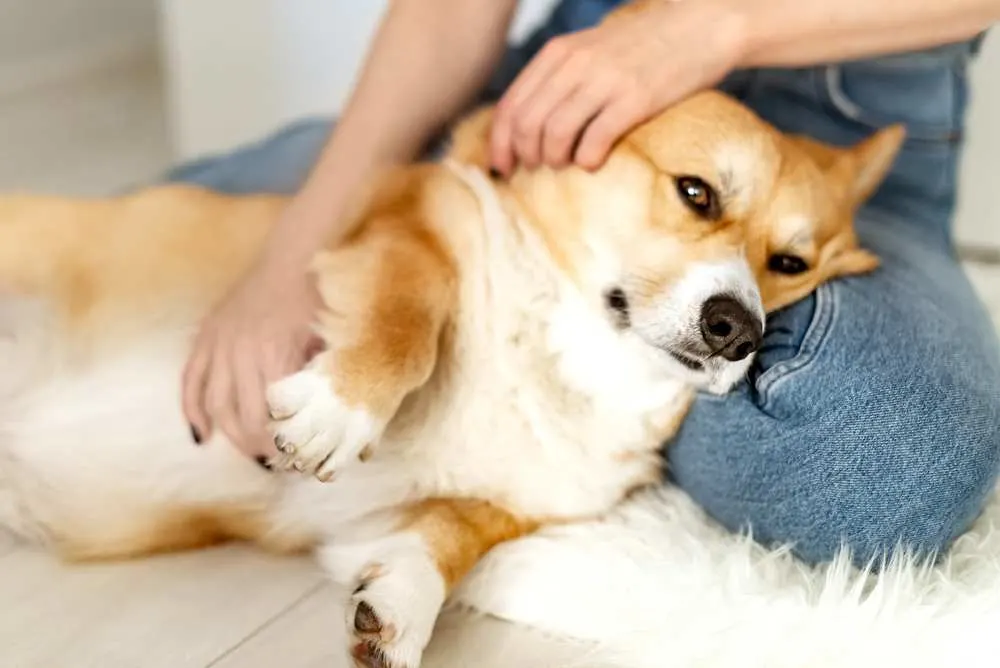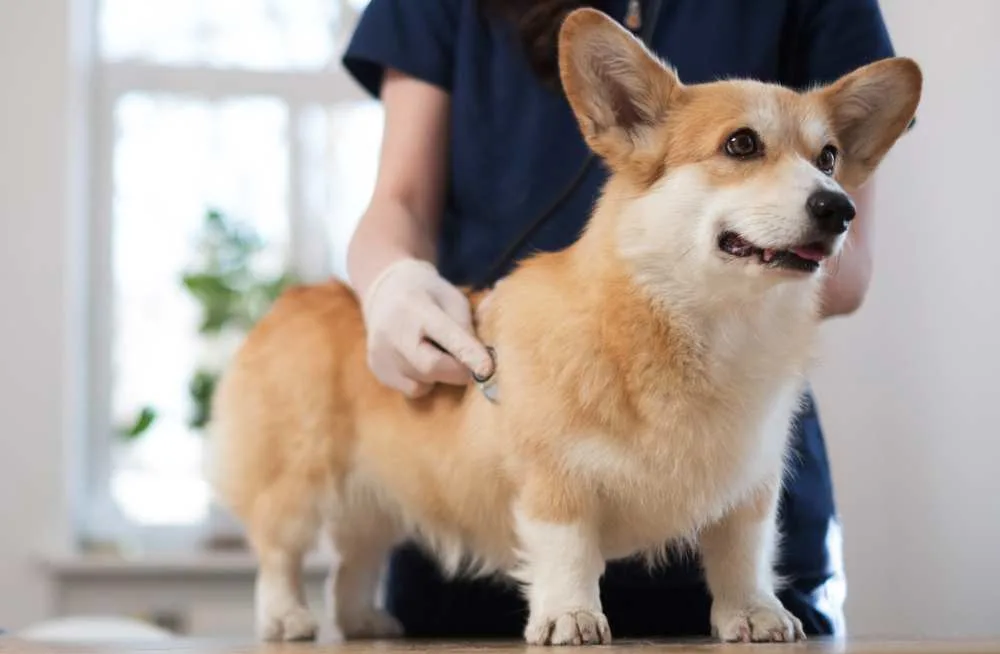All dogs make great pets and will give you their loyalty and love; it does not matter whether they are a Corgi mix or any other type of breed. Still, we must admit that there is something special about Corgis. Their personality and looks make a perfect symbiosis hardly anyone can resist. It’s a fantastic breed, indeed.
Corgi Lifespan: 12 – 15 years
Do Corgis die young? Well, when your best friend dies, it is always too soon. However, with an average lifespan between 12 and 15 years, your Corgi should live longer than many other breeds of dogs, especially those larger in size. If you are fortunate, maybe your Corgi can live even a few years more than expected since some Corgis have reportedly lived an incredible 18 years.
The Corgi lifespan is not definite; you can do much to prolong your best friend’s life. The best way to do this is to make sure your pet gets the best possible care and is well-loved. We will help you learn all there is about Corgis so that you can keep your dog happy and healthy for a long time and enjoy your time with him or her worry-free.

A Short Introduction To Corgi Breed
Corgis have gained planetary popularity and are now beloved pets to people all over the globe. Still, their story is closely connected to England. They can thank the British Royal family for making them super-famous both in the UK and worldwide.
The Corgis have a much longer history than you can even imagine. Back in the old days, they did not enjoy the perks of royal life. Corgis originated in Wales, where they served as herding dogs. Their primary role was to help farmers take care of cattle and sheep. Highly-intelligent Corgis had no trouble doing this.
Corgis are tiny dogs. Their small body is quite strong, though. Still, it does not come as a surprise that their name translated from the Welsh stands for a dwarf. They really look like little dwarfs when next to some other herding dogs such as German shepherds. In fact, Corgis are the smallest breed among all the herding dogs.
What About Their Personality?
Having a strong herding instinct, Corgis are great with kids. They are playful and gentle but protective as well. They might be small but they have a big bark. If you want a loyal companion and a loving dog – Corgi is an excellent choice.
You can learn even more about Corgis’ temperament here.

Types Of Corgis
Queen Elizabeth II’s Pembroke Welsh Corgi has been so famous that many people immediately think of him when someone mentions this breed. However, Pembrokes aren’t the only Corgis out there. The Cardigan Welsh Corgis hail from Wales as well. Both types have quite an impressive history and make excellent pets.
People often confuse these two types of Corgis even though there are some quite noticeable differences between them.
How can you tell the difference?
We will help. Pembroke and Cardigan Corgis have quite a different history and a few traits that are sure to help you make a distinction between these two types of Corgi breed. Check it all out:
| The Pembroke Welsh Corgi | The Cardigan Welsh Corgi | |
|---|---|---|
| History | Pembroke Corgis have quite a long history that goes back to the 10th century. It is believed that they came to England on Viking ships. A legend says that Pembroke Corgis are enchanted dogs that fairies and elves use to pull their carriages. Many dogs of this breed have a fairy saddle on their back – distinctive markings on their shoulders that resemble saddles. | The Cardigan Corgis have a rich history too. They came to England from Central Europe, somewhere around 1200 B.C, which makes them one of the island’s oldest breeds. The Cardigan Corgis were not used to herd cattle – quite the opposite; their role was to drive the cattle off the “common” pastureland. |
| Appearance | They are about a foot tall and weigh around 30 pounds. They are short but have strong legs and muscular thighs and are quite powerful dogs in general. Their red and white coat is very thick. The most distinctive feature is that they are born without a tail. | They weigh about the same as Pembroke Corgis. Usually, not more than 34 pounds nor less than 25 pounds. They have a similar thick coat but come in various colors, from red to bluish shade. They have a tail, too – that is the main difference you can rely on to set them apart from the Pembroke Corgis. |
| Personality | Extremely bright and playful, but also very smart and easy to train. They are fearless and bold and often show their independent streak. Still, they are rarely aggressive and are thus suitable for kids as well. | They are equally smart as their Pembroke relatives, and they need to be continuously stimulated. Cardigan Corgis prefer being out and running freely to being tied down or inside. They, too, are an excellent choice for kids. When properly socialized, Cardigan Corgis will get along with any other pet you might have. |
| Grooming | Ideally, Pembroke Corgis should be combed and brushed every day since their coat sheds a lot, especially during spring and summer. You should clean their ears regularly as well. | Their coat needs to be brushed at least once a week so that it does not shed too much. You need to trim their nails and the hair underneath their claws so that it does not catch too much dirt. |

Are Teacup Corgis A Type Of Corgi Breed?
Many people nowadays live in tiny apartments, especially in big cities. For this reason, teacup Corgis have become highly popular and sought for. Even though average-sized Corgis are quite small, too, many still find them inappropriate for their small homes.
What Is The Difference Between Normal-sized Corgis And Their Tiny Relatives?
While Pembroke and Cardigan Corgis are dog breeds with a long, rich history, their teacup relatives have been around for a relatively short time. People have actually made these tiny dogs fit their busy lifestyle.
How Are Teacup Corgis Created?
There are three different ways you can rely on when you want to “create” a teacup version of a Corgi. Each method has its own drawbacks and difficulties, though.
1. Mixing With A Smaller Breed
The most common way to make a teacup Corgi is to breed a normal-size Corgi with a member of some smaller breed. It is the easiest way, too. This method rarely fails since mixed puppies typically get both parents’ traits, and they thus turn out smaller than a regular Corgi.
Unfortunately, puppies will most likely inherit other traits from another parent as well, not only their size. As a result, they can end up looking quite different from Corgi. The good thing is that mixed breeds are typically very healthy – this is what makes this method the most desirable of them all when it comes to breeding miniature dogs.
The most common breeds that are mixed with normal size Corgis are Chihuahuas and Dachshunds.
- Corgi Chihuahua mix puppies are bound to be smaller than regular Corgis since Chihuahuas are among the most miniature breeds of dogs in the world. Unfortunately, they will not look precisely like Corgis nor be as friendly and good with kids and other pets. Chihuahuas are often aggressive towards people and other animals. Early socialization might help resolve this issue.
- Corgi Dachshund mix puppies are more likely to be similar to a normal-size Corgi, only smaller. The Corgi and Dachshund dogs look alike. They have a long body and short legs. As a result, their puppies should resemble Corgis more. On the downside, Dachshunds are prone to back problems, even more so than Corgis themselves. The short legs cannot support their back properly, and thus IVDD is extremely common. If you choose such a puppy, make sure you provide him or her with regular exercise and a healthy diet – since every extra pound it gains bears a risk.
2. Introducing The Gene For Dwarfism
Another way to “create” a teacup Corgi is to introduce the gene for dwarfism. It is a straightforward method, but quite complicated too. You cannot merely breed a puppy with the dwarfism gene. This gene has to result from a random mutation or mixed breeding. Some breeds are more prone to this specific mutation than others, while some never exhibit it.
The Corgis already have a form of dwarfism. The achondroplastic dwarfism Corgis have, inhibits the natural process of turning cartilage into the bone during fetal development. This is why Corgis have such short legs in the first place. It makes Corgi so cute but also causes specific health issues. The short limbs cannot support the Corgi’s long back, and thus, problems such as IVDD occur.
3. Breeding Runts
Let us warn you right off; you should avoid breeding runts in an attempt to create a teacup Corgi. What are runts? Runts are dogs that are smaller than average. If you were to breed two runts, you would get a smaller than average puppy too. The problem is that runts are little for some reason – it usually has to do with some health problem that can be inherited. In this way, your teacup Corgi is most likely going to be unhealthy too.
Should You Get A Teacup Corgi?
If you opt for a puppy that is a result of a mixed breed method, it should be a healthy small pet that can make you happy for years to come. It might not look exactly like Corgi, but it will not have any health issues either. Mixed breed Corgis might not be the best option if you have small kids since they often mishandle tiny dogs and can contribute to back problems and IVDD.
Here are some benefits of owning a teacup Corgi:
- This tiny dog requires minimal living space.
- Small dogs require less exercise than large dog breeds and are thus appropriate for less active people or lack the free time to regularly walk the dog.
- Teacup Corgis look like puppies for longer.
- Small dogs are much easier to transport than larger dogs and are thus an excellent choice for people who are constantly on the move. They are easier to accommodate in cars or on planes, as well as hotel rooms. In fact, many hotels have limited the weight of the dogs they allow.
How Long Do Teacup Corgis Live?
Small breeds generally have a similar life expectancy. Therefore, there shouldn’t be much difference between the expected lifespan of a teacup Corgi and a normal-sized one.

How Long Do Corgis Live?
It is now time to get back to our main question of the day: How long do Corgis live for? We have already answered the question: How long do Corgis live in human years? You now know that you can expect up to 15 years of fun and love with your best friend Corgi. But, how long do Corgis live in dog years?
It is not that easy to calculate dog years since the old theory we believed in for so many years that one dog year equals seven human years is no longer supported by the scientists and vets. Scientists now know that different breeds age differently. Luckily for Corgis, it has been established that smaller breeds are expected to live longer than large ones.
The new theory that has been based on a 2019 study suggests a different formula to convert human years into dog years and vice versa. It is based on changes that dogs’ DNA goes through overtime.
So, how can you calculate dog years to human years correctly?
The American Veterinary Medical Association provided us with a general guideline that will enable you to calculate your Corgi’s age properly. Here are the main principles the new theory relies on:
- A small and medium dog’s first year of life equals fifteen human years.
- The second year of your dog’s life equals nine human years. It means that at age two, your dog is already a teenager.
- From year three and all the way to the very end of your pet’s life, each human year equals approximately five dog years.
So, how long do Corgis usually live in dog’s years? Let’s calculate that together:
If Corgi’s life expectancy is 15 human years, your dog should be about 89 years old when he or she dies. How did we reach this number? We’ll show you step by step:
- The first year of your Corgis life equals 15 human years.
- The second year of your Corgi’s life equals 9 years.
- The remaining 13 years of your Corgi’s life equal 5 human years each.
The formula is as follows:
15 + 9 + (13 x 5) = 24 + 65 = 89
As you can see, your Corgi will be quite old when it gets to the time to say goodbye. We know that you would like for you two to stay together forever, but unfortunately, the dog’s life expectancy cannot measure up to that of humankind.
The good news is that you can help your Corgi live a happy, healthy life and reach maximum years. How can you do that? Stay tuned, and we will tell you!
See Also: Are Corgis Endangered? Are Corgis Going Extinct?

How Can You Help Your Corgi Live A Long & Happy Life?
It doesn’t really matter how old are Corgis when they die if they have had a memorable life. All Corgis, and dogs in general, should have a happy, healthy life, filled with love and affection – that’s what really counts.
Your role as a dog owner is to make sure your pet gets the best possible care. In order to do this, you have to get acquainted with all the needs and special requirements your dog might have.
Every breed has a weak spot. Corgis, for example, are prone to getting overweight and having problems with their spine. If you love your Corgi, and we are sure you do since their lively personality is almost impossible to resist, check out the following diet recommendations and the detailed list of health concerns that affect Corgis.

Diet Recommendations
All dogs require a well-designed diet plan that fits their specific needs; Corgis are no exception to this rule. Moreover, being prone to getting overweight, Corgis need a well-balanced diet and exercise plan. When making this plan, you have to consider your dog’s age too. It is always a good idea to consult a professional.
It would be best to consult a vet as soon as you bring your Corgi pup home. In this way, you will start off on the right track and avoid creating bad eating habits.
The most important thing is that you should feed your dog only when it is meal time. Avoid feeding him or her off your plate and giving them too many treats. You can show your dog love in so many different ways – there is no need for overfeeding.
Corgis’ diet should be protein-based since they need high-quality food to secure enough energy without too many calories. It would be smart to keep an eye on how many calories your Corgi takes every day since that is the best way to prevent weight gain and all the other health issues resulting from it.
Both Cardigan and Pembroke Corgis will get chubby very quickly if fed inappropriately. Thus, it is best to serve your Cordog’swo smaller meals a day and avoid giving him or her one big meal. It should speed up your dog’s metabolism and help him or her maintain a healthy weight.

The Most Common Health Concerns That Affect Corgis
Both Pembroke and Cardigan Corgis are prone to specific health problems. We have made a detailed list of the most common issues.
Degenerative Myelopathy
Degenerative myelopathy (DM) is probably the worst health issue that your Corgi is likely to face. It affects your dog’s spine and, sadly, in most cases, ends up badly. These fatal diseases usually affect Corgis at the age of eight or nine. You can perform a test much earlier than that to find out if your Corgi has a gene that increases the risk of this disease so that you can try to prevent it or at least postpone it.
What are the signs that your Corgi suffers from degenerative myelopathy?
- Loss of coordination (ataxia) in the hind limbs
- Wobbling when walking
- Drag the back feet
- Difficulty standing
- Inability to walk
Unfortunately, there are still no treatments that can stop the progression of DM. You can at least try to improve an affected dog’s quality of life by securing proper nursing care and physical rehabilitation. The mobility can be enhanced through the use of harnesses and carts.
Von Willebrand’s Disease
Von Willebrand’s disease is a hereditary blood-clotting disease. If your dog has it, you should be extra careful since even the little cut or wound can lead to excessive bleeding. Numerous signs can warn you of this condition, including the following:
- Blood in the feces
- Nose bleeding
- Gum bleeding
Luckily, Von Willebrand’s disease is rarely life-threatening; your dog can live with it and be playful as ever before. Still, it would be a good idea to screen breeding animals so that you can avoid passing on this genetic disorder. If you do not know if your Corgi is affected or not, we recommend a screening test, especially if you are considering major surgery.
Hip Dysplasia
Hip dysplasia is not reserved for Corgis – it affects many dog breeds. The problem occurs when hip joints do not develop properly. Hip dysplasia can also be a result of an injury that damages cartilage.
It is a painful condition that reduces your dog’s quality of life and limits his or her mobility. Even though large dogs have a genetic predisposition for this condition, small breeds such as Corgis can be affected as well. Insufficient exercise and improper weight and nutrition increase the risk.
Some dog foods and supplements that contain glucosamine can help prevent this painful condition or help your dog feel better. Anti-inflammatory medications and joint fluid modifiers are a standard treatment as well. You can help by controlling your dog’s weight and helping him perform prescribed exercises.
Elbow Dysplasia
Elbow dysplasia is more-less the same as hip dysplasia – it only affects another part of the dog’s body.
Learn More: Are Corgis Expensive To Maintain?
Extra Tip: Be careful when choosing toys for your Corgi too. Consider your pet’s size and age. If a toy is too small, it represents a choking hazard. A toy that is too large will not inspire your Corgi to play. You should always supervise your Corgi when you give him a new toy and make sure there are no problems.

Final Recommendations: Taking Care Of Your Corgi
Owning a Corgi is sure to brighten up your life. Both Pembroke and Cardigan Corgis are loyal friends that you are sure to fall in love with. The good news is that Corgis have quite a long life expectancy – that means that you get to spend more than a decade with your best friend.
Of course, like all dogs, Corgis require adequate care to stay healthy and happy. The most important thing is to plan your dog’s diet carefully and in tune with your vet’s recommendations. Next, you need to make sure your Corgi gets plenty of exercise on a daily basis. In return, your Corgi will be your faithful companion and will give you years of loyalty and love.
Read Also: What Do Corgis Usually Die From? How Can You Help Them?

